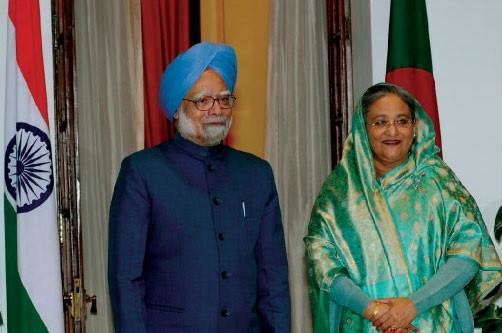 In 2009, the installation of the Awami League government in Bangladesh and the Congress party in India created a congenial ambience to build a stronger bilateral architecture.
In 2009, the installation of the Awami League government in Bangladesh and the Congress party in India created a congenial ambience to build a stronger bilateral architecture.
Bangladeshi Prime Minister Sheikh Hasina’s landmark four-day visit to India in January 2010 created an excellent environment of mutual trust that sought to lay the foundations of a much more mature, stable and fruitful relationship with India.
A catalogue of positive gains reveals that the visit has achieved a new direction in bilateral relations, thus benefitting both countries.To begin with, the Hasina government has moved quickly to address New Delhi’s concerns on cross-border terrorism (including expelling top ULFA insurgents to India) and connectivity with the Northeast.
In addition, Bangladesh has agreed to provide transit facility through Bangladesh’s Ashuganj port for transportation of heavy duty equipment for ONGC Tripura Power Company (OTPC)’s 727 MW gas-based project located at Palatana in Tripura.
In May this year, the Bangladeshi government agreed to transport 10,000 tonnes of foodgrains for Tripura through its territory. It is reported that Bangladesh has also agreed to allow 100026 MW electricity generated from 429 dams in Northeastern states though Bangladesh to West Bengal and to other places in India.
COncomintantly, India has provided 24-hour access across Tin Bigha to Bangladeshi residents in the enclaves of Dahagram and Angarpota. India began to export 500MW electricity to Bangladesh (India would get more than US$350 million annually), and 250 MW electricity from 5 October 2013.
Many infrastructure projects are being implemented under the supplier’s credit loan of US$800 million dollar from India (US$200 million of the US$1 billion loan was converted into a grant).
Bangladesh and India are reportedly dredging common rivers to restore navigability and prevent flooding. Ichamati river has been dredged over a 20-km stretch for the past two years.
Bilateral trade has increased to US$563.9 million as of 2012-13, from $100 million a few years ago. Border haats at Kalaichar and Balat in Meghalaya are in operation. The proposal for establishing four border haats along theBangladesh-Tripura border has agreed upon.
The Maitreyi Express (Friendship Express) was launched to revive a railway link between Kolkata and Dhaka that had been shut for 43 years. In addition, the Kolkata-Dhaka government bus is operational.
However these aforesaid positive gains of partnership have been overshadowed by a number of events. One, border-fencing is perceived to display the unfriendly sentiment of India towards the people of Bangladesh. Does the barbwire fencing of 3,300 kilometres India a trusted friend? It is therefore asked if the land transit through Bangladesh to the Indian Northeastern states is compatible with the spirit behind the fencing the Indo-Bangladeshi border.
The Bangladesh-India border has become very dangerous, with many Bangladeshi deaths occuring at the hands of 'trigger-happy' BSF soldiers, which is contrary to the Indo-Bangladesh Joint Statement of January 2010 (paragraph 18). The continued abduction, senseless torture and killing of Bangladeshis by BSF at the border have led an overwhelming section of people in Bangladesh to believe that India does not care about the loss of lives of Bangladeshis.
The failure of the Teesta water-sharing deal and the non-ratification of the land boundary protocol signed during PM Manmohan Singh's visit in September 2011 (as envisaged by the 1974 Mujib-Indira Land Boundary Agreement) have put into serious question the credibility of the Indian government to keep its pledges with Bangladesh.(Bangladesh ratified the Agreement in 1974).
Having said that, Bangladesh is aware of the difficulties that New Delhi faces with the BJP opposition and the West Bengal government in concluding these deals. These disputes between Bangladesh and India also directly involve the Indian states of West Bengal, Assam, Tripura, Meghalaya and Mizoram, and the Congress-led government at the centre needs to seek their views, especially when some of the states are not ruled by Congress governments, before making internaitonal deals.
Although cross-border interactions through visits, including cultural exchanges, have increased in recent years, the channel of electronic communications from Bangladesh to India is blocked. In Bangladesh, TV viewers watch India’s cable channels, while in India, Bangladeshi TV channels (more than 20 in number) are denied to the Indian people.
One of the biggest challenges therefore is addressing the asymmetrical nature of the connection between the two countries. Interactions with Indian interlocutors threw up a revealing question: does India really need Bangladesh as much as Bangladesh needs India? There are no easy answers to this question, but finding ways to address it should be a major preoccupation of political leaders on both sides.
Harun ur Rashid is Former Ambassador of Bangladesh to the UN, Geneva
Courtesy : Institute of Peace and Conflict Studies (http://www.ipcs.org)